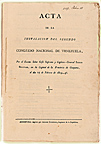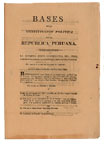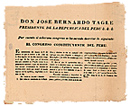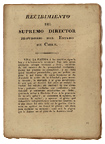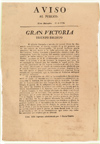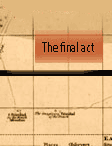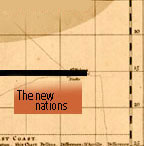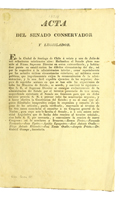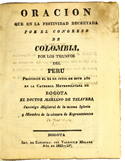| |
The Age of Spanish American Revolutions:
Forming the New nations
|
|
|

Congress of Angostura
Venezuela, Acta de la instalacion del segundo congreso nacional de Venezuela (Angostura: Impreso por Andres Roderick, impresor de la República, 1819).
The Congress of Angostura was convoked by Simón Bolívar in early 1819 and ultimately led to the creation of Gran Colombia, a union of today’s independent nations of Venezuela, Colombia, Ecuador, and Panama. Bolívar’s vision for the constitutional structure of the republic included a strong, centralized executive, a hereditary senate, and a fourth branch of government, the “Moral” branch, “to nurture men with virtue and keep them in line,” as Bolívar wrote to his friend Guillermo White. Although not adopted into the Venezuelan constitution, this idea was a part of the constitution of Bolivia, written by Bolívar for the nation named after the Liberator.
Acquired with the assistance of the Donaldson Charitable Trust
|
|
| |
|
|
|
A constitution for La Plata
Provincias Unidas del Río de la Plata, Constitucion de las Provincias Unidas en Sud-America (Buenos-Ayres: Imprenta de la Independencia, 1819).
As the nascent nations formed their governments in the north and the south, there were opposing visions of the proper relationship between the central government and the provinces. The Federalists supported giving greater autonomy to the provinces, while the centralists, or Unitarians, favored a strong centralized form of government. In La Plata, the centralist constitution of 1819 was opposed by the provinces of Santa Fe and Entre Rios, who joined forces in 1820. |
|
| |
|
|
|
Civil War
Al exercito de Buenos-Ayres, 1820.
San Martín and Belgrano were called away from pursuing Royalist forces in the north, but both refused to engage in a civil war. This flyer, issued by the ultimately-successful Federalist army and directed to Unitarian troops sent from Buenos Aires, offers full pardon to deserters, and the rank of Capitan to deserters who brought with them 80 men. |
|
| |
|
|
|
Outlines of a constitution
Peru, Bases de la constitucion politica de la republica Peruana (Lima: Imprenta del Gobierno, 1822).
Among the last regions to fall to the Republicans, Peru began work on a constitution in 1822. After hearing mass and swearing an oath on the scriptures to preserve the Catholic faith, the first Peruvian Constituent Congress set to work in formulating a constitution. This basic outline of the plan for the Peruvian Constitution was adopted in December of 1822, but the elaboration of the full constitution would take yet another year. Read the entire item on Internet Archive.
Acquired from the estate of Maury A. Bromsen |
|
| |
|
|
|
Freedom of the press
Peru, El protector de la libertad del Peru. Desde que se inventó el arte libertador de la imprenta (Lima: s.n, 1821).
During the viceregal period, the press had been regulated by crown authorities and subject to tight control by the religious establishment and the Inquisition. During the wars of independence, many proclamations and propagandistic pieces were printed, occasionally from field presses or even aboard ship. This proclamation establishes freedom of the press in Peru, while simultaneously prohibiting works defamatory to the Catholic Church and establishing a tribunal to review cases of libel. Read the entire item on Internet Archive.
Acquired from the estate of Maury A. Bromsen |
|
| |
|
|
|
Disintegration of slavery
Peru, El á lo ofrecido á los esclavos en la proclama que les dirigí a principios del presente mes (Lima: s.n, 1821).
Read the entire item on Internet Archive.
|
|
|
Peru, El Protector del Peru. Uno de los deberes del gobierno es promover la libertad (Lima: s.n, 1822).
The Peruvian constitution did not, however, put an end to slavery, which would continue until 1854. These two proclamations help illustrate the gradual process of abolition, which some historians instead refer to as the “disintegration” of slavery. The first provides for liberty, by lot drawn each 7 September, to be granted 25 slaves who fought on patriot side, but only if they had returned to their masters following cessation of hostilities. The second grants liberty to slaves who had belonged to Royalists who left Peru, but then either enlists them in the military or puts them to “some useful occupation.” Read the entire item on Internet Archive.
Acquired from the estate of Maury A. Bromsen |
|
| |
|
|
|
Reinforcing the troops
Peru, La suprema junta gubernativa del Peru ha acordado y decreta. (Lima: s.n, 1822).
In addition to enlisting the former slaves of Royalists, the Republican forces sought to enlist those who had earlier been exempt due to age or health reasons, in order to bolster their forces for the final push towards independence. Read the entire item on Internet Archive.
Acquired from the estate of Maury A. Bromsen |
|
| |
|
|
|
Riva-Aguero: Traitor
Peru, Don Jose Bernardo Tagle presidente de la republica del Peru &. &. &. Por cuanto el soberano congreso se ha servido decretar lo siguiente. (Lima: s.n, 1823).
José de la Riva-Aguero who had written from Buenos Aires in 1818 in support of the Republican cause, later served briefly as the president of Peru. During his tenure, however, Royalist forces re-entered Lima and the government removed to Callao to await Bolívar. Riva-Aguero’s successor, José Bernardo Tagle, declared him a traitor, believing that he had conspired to delay Bolívar in order to retain the presidency. Read the entire item on Internet Archive.
Acquired from the estate of Maury A. Bromsen |
|
| |
|
|
|
Peru’s Constitution
Peru, Constitucion politica de la republica Peruana jurada en Lima el 20 de noviembre de 1823 (Lima: s.n, 1823).
The Peruvian Constitution of 1823 recognized José Bernardo Tagle as president of the republic. Nevertheless, the constituent congress almost simultaneously issued a law recognizing Simón Bolívar as the ultimate political and military leader, or perhaps better, nullifying any clause of the constitution that contradicted Bolívar’s orders. With the wars of independence unfinished, however, Bolívar did not remain in Peru and continued political strife saw the replacement of this constitution with a second in 1826. Read the entire item on Internet Archive.
Acquired with the assistance of the Sophia Augusta Brown Fund |
|
| |
|
|
|
Conservatives in Chile
Ramón Freire, Recibimiento del supremo director provisorio del estado de Chile (Santiago de Chile: Imprenta nacional, 1823). Read the entire item on Internet Archive.
|
|
|
Chile, Acta del senado conservador y legislador (Santiago de Chile: s.n, 1824).
Bernardo O’Higgins had been Supreme Director of Chile from 1817, but was deposed by a conservative faction in 1823 and Ramón Freire was installed. The conservatives issued a constitution that closely regulated the private and public behavior of the citizenry, much as Bolívar’s proposals for a fourth, moral, branch of government for Venezuela would have done. It proved more than difficult to implement, and in 1824 Freire was granted extraordinary, almost dictatorial, powers. Nevertheless, conflicts among the various political factions forced him to retire in July of 1826. Read entire item on Internet Archive. |
|
| |
|
|
|
Victory at Ayacucho
Aviso al publico. Lima diciembre 18 de 1824: Gran victoria triunfo decisivo (Lima. 1824: Imprenta administrada por J. Maria Concha, 1824). Read the entire item on Internet Archive.
|
|
|
Mariano de Talavera, Oracion que en la festividad decretada por el congreso de Colombia, por los triunfos del Peru (Bogota: Imp. de Espinosa: por Valentin Molano, 1825).
The victory of Republican forces at Ayacucho has been seen as the symbolic end of the wars of independence in South America, although the fighting in Upper Peru continued for another year. The victory was announced and celebrated throughout South America with festivities and sermons of thanks. Although independence was assured and irreversible, the region experienced civil wars and political turmoil for many ensuing decades. Read the entire item on Internet Archive.
Acquired with the assistance of a gift from Artemis Joukowsky and the Special Projects Fund |
|
|
home |
|
